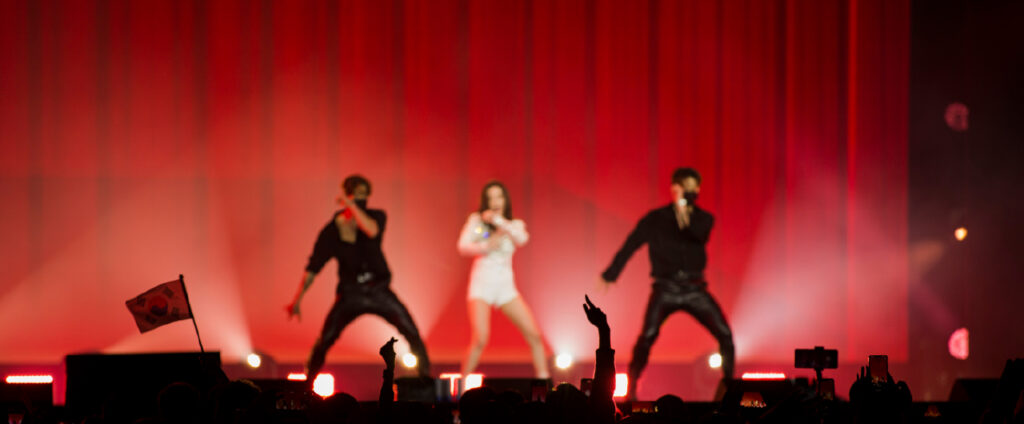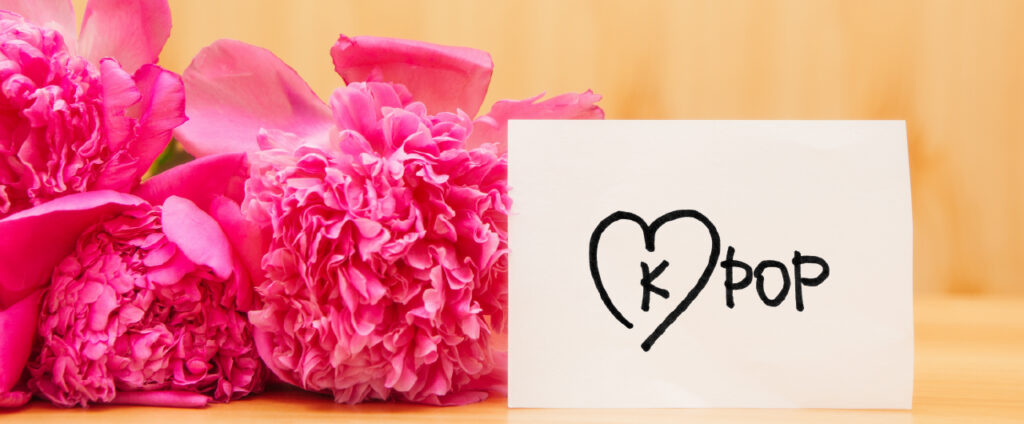El Kpop orKorean Pop has gained popularity and has been included in the most important music charts in the world since 2016, so much so that it currently generates an income of more than 10.000 million won Koreans (official currency) to their country of origin, South Korea. But do we really understand the unique language of this musical culture? Here we bring you the Kpop Dictionary, with the most relevant terms to understand kpopers.
What is Kpop?
Many think and define Kpop as a musical genre, but it is much more than that. Kpop, more than just being pop, despite its name, is the expression used to refer to the musical style of South Korea.
This involves all genres of everyday music like R&B, Rock, Pop, Rap, EDM, Disco, Classical, Electronic, Hip Hop and much more.

30 vital expressions in the Kpop dictionary
The Kpop vocabulary is very broad and varies depending on each group or artist and their fandom, each one has an authentic language and full of internal references. However, there are the following series of expressions in general use that you should know so as not to be so lost when talking to a kpoper.
Kpoper
The calls kpoper They are those people who like Kpop, regardless of which fandom they belong to.
This term is generally used from people who are not fans of this musical style to those who are. In other contexts, such as among fans and followers, it is used to refer to people who do not follow a specific group or artist, but listen to the style openly.
Aegyo
This musical style is characterized by developing the culture of aegyo, as part of the shows captured on camera. He aegyois the Korean expression that refers to “acting cute”.
In other words, when fans ask their artists to act cute, they minimize the tone of their voice and accompany it with facial and body gestures. cute.
Furthermore, aegyo can occur in three ways:
- Natural tenderness, when it is not planned.
- Requested by fans, when artists do it for their followers in audiovisual programs.
- Comedy act, when done for the purpose of being funny or giving cringe.
Take a look at these examples:
Sasaeng
This is the name given to obsessed fans.
Yes, a common situation for Kpop artists and groups is being chased or harassed by these excessive fans, who usually follow them to most of the places they go. Therefore, Korean and international fans use this Korean word to refer to such people.
Bias
This word comes from English and is used to talk about a fan’s favorite member of a certain group or their favorite Kpop artist.
It can be used for several artists, that is, in the plural. In addition, there are recognized types such as the Bias Wrecker, who is a second favourite, or an artist who becomes a favorite for a certain time, or the Ultimate Bias, which is the favorite among all the favorites.
Also, to talk about fans of specific artists or members of a group, this word becomes an adjective. For example, in the case of EXO (Kpop male group), someone can be Kai biased, Xiumin biased, Chanyeol biased, etc.
OT + Number
If the previous expression is to refer to favorites, this is seen when a fan follows a group and likes all its members equally, that is, without distinction of any kind.
The letters OT are mentioned and the total number of members is added.
For example, in the case of Black Pink (girl group), the fan would be OT4, as this is the total number of members of the group. On the other hand, if it is Twice (girl group), it would be called OT9.

Stan
It serves to refer to the same fans and works in a similar way to the term biased. If you are a stan, you follow and support a Kpop artist or group. It also applies to a quality that you have as a fan or that applies to people you like.
There are several types as well:
Hard stan:
Is when staneas strongly and constantly to your favorite artist or artists, when you already have some expertise in the fandom and are updating the information you know frequently.
Soft stan:
It is used when you prefer the cute and kind version of Kpop artists.
Multistan:
This word is for those fans who like more than one or two groups, those who are a faithful part of various fandoms. While the kpoper They are the ones who listen to Kpop, the multistan are the ones who like specific artists or groups.
Lightstick
In Kpop culture, it’s also easy to identify those little lights that fans bring to every concert and take care of with all their efforts. These lanterns are called Lightsticks.
These not only serve to encourage artists at concerts, but also to identify you as part of a fandom; It is a symbol of pride and fidelity. Each group and solo artist has an exclusive and distinctive lightstick designed for their fandoms.

Black Ocean
This expression refers to the moment in which fans turn off their lightsticks to show their discontent with a certain artist or group, that is, as a way of protest, rejection or visible complaint.
It is very rare, but there have been several cases in which it happened. For example, there is the one of T-ARA (ex-girl group) in 2011 during the Dream Concert, which occurred due to a bullying controversy that the group was experiencing at that time.
Comeback
When we want to talk about the release of a new album, the term is mentioned Comeback. Unlike what happens in the West, in South Korea, these releases are highly relevant and create very high expectations among fans.
For this reason, this word is widely used for those moments and even the special premiere programs for each album are called Comeback stage.
Daebak
Again a Korean expression… This is used when you want to show enthusiasm or surprise about something or you want to say that something is cool. It is equivalent to exclaiming “Incredible!”.
Aigoo or Aigo
These expressions are used to show various emotions such as worry, fear, etc., in Korean. It is heard a lot in the speech of artists and often rubs off on Kpop and Kdrama fans.
Debut
TheDebut It is like the “premiere” of the group or artist, that is, its first presentation, its first album or when it is presented to the public for the first time. Likewise, there is the word pre-debut, which refers to all the events and promotions made before the debut.
Fanchant
Before or during each presentation or concert, the fandoms sing some verses that go with the rhythm of the song. These verses contain the names of the members of the group or the artist that is going to be presented, in such a way that it gives the opening or acts as a group to encourage the artists.
Take a look at the example of a GOT7 (ex-boy group) fanchant:
Fanmeetings
This term is used to refer to the meetings of Kpop artists with their fans. In many cases, there is a time to sign fan albums and interact with them.
Hiatus
When a member of a group or artist takes a break or withdraws from certain activities, that period is considered a hiatus. There are some long ones and other short ones that depend on each particular situation.
Idols
This is how Kpop artists are mainly known. A kpoper usually calls them Idols orK-Idols failing that. Additionally, it is associated with the word idolin Spanish.
MV
This acronym refers to Music Video, which are the official videos of each group or idol. These can be given at each comeback or by special releases.
Trainee
Before becoming an idol and debuting, all applicants must enlist, audition, and train with a training agency. People who perform this type of preparation are called Trainees.
Being a trainee does not guarantee that you will become an idol, since you must pass tests, demonstrate your skills and talents, and be approved for debut.
V Live
This is the name of an online streaming video platform, in which Kpop artists and groups do live talks or present relevant information about their comebacks. They can even do individual lives to interact with fans.
Mutis
It’s the loving version of Mutuals and it is used when you refer to someone with whom you share the same taste for the same idols or groups.
PC
No, we are not talking about the computer. Interestingly, the acronym PC breaks down as PhotoCard. This is, as the name says, a mini photo of an idol or group in the form of a card, which is included within the albums and can be collected together with others.
Daesang
During the year-end seasons, at the Seoul Music Awards (SMA), idols can be nominated for Daesang. o Artist of the Year Award. It is also known as the Grand Prix and is considered a great honor in the Korean music industry.

Ship
Ships are close relationships between two idols from the same or different groups, or solo idols with other idols. Some are of a romantic type and others are to highlight the so-called soulmates or friendships destined to exist.
Likewise, they can occur between people of the same or different sex.
Acronyms BG and GG
These expressions are the reduced version for Boy GroupandGirl Group. On other occasions, the terms Male Group or Female Group are used, and even Male Artist or Female Artist.
All rounder
These words are used to talk about an idol with the ability to “do everything right”. In other words, when an idol is good at all the activities that he should do naturally, he is called an idol. All rounder.
Fancam
In each event, the fans are in charge of recording every moment from their perspective. These recordings are called fancams and, from them, other outstanding videos emerge later.
Generations and Eras
In Kpop, emphasis is placed on the evolution of Kpop music itself. That’s where you start talking about generations and eras.
Generation
So far, 4 generations are known, which are characterized by the change of popular rhythms and the aesthetics of the musical style. So, currently, the fourth generation is in force with groups like ITZY and TXT.
Was
The era, on the contrary, corresponds to the different albums or comebacks of each group or artist. For example, in the case of NCT Dream (a sub-unit of the boy group NCT), there are eras like My First and Last, Go, Hello Future andGlitch Mode, which correspond to each album and have particular characteristics from each other.
FMV and Edits
The Fan Made Videos (FMV) andEdits They are short videos made by the fandoms themselves to highlight a facet or situation linked to their favorite idols or groups. They are usually found on social networks such as Facebook, YouTube, TikTok and Instagram.
Duality
It is used to make the distinction between two facets that idols show as part of their charisma on stage, which are hot andcute. When an idol or group has both facets, it is said to have duality or duality.
Stage presence
It refers to the charisma on stage that each idol displays during their performances.

Bonus: Treatment formulas in the Kpop world
The way idols express themselves in Korean depends on factors such as age, how long they have been in the industry, and their position or characteristics in the Kpop group or industry. Learn about the most important below:
Hyung
It is used between men and to refer to older men who are speaking.
Unnie
It is used between women and to refer to older women to whom you are speaking.
Oppa
It is used to refer to older men, if it is a younger woman who is speaking.
Noona
It is used to refer to older women, if it is a younger man who is speaking.
Sunbae
It is used to refer to women or men who debuted before the person speaking.
Dongsaeng
It is used to refer to women or men who debuted after the person speaking.
Lines
In Kpop, the calls are made lines when grouping different members of a group because they have certain characteristics or because of their position within it.
For example, the hyung line (the oldest members of the group), the maknae line (the minor members of the group), the rap line (the rappers of the group), the vocal line (those who sing high notes), the dance line (the dancers) and so on.
Lines can even be made through the place of origin of the members, such as the Aussie line and the American line.
Maknae
This is the name given to the youngest person in any Kpop group.

Tips to communicate with a kpoper
Keep in mind the following tips to get to know the kpopers around you better:
- There is not only BTS. Although it is well known, there are many other entertainment groups and companies. Therefore, do not assume that all kpopers are ARMYs (fans of BTS).
- Try to be receptive and careful. If you talk about Kpop without having researched, you’ll be talking based on stereotypes.
- Each group has its references, there is an internal vocabulary among fans
- Don’t call them Chinese or Japanese. Although there are fans who are more tolerant of this topic and are willing to explain it to you, most prefer that you express yourself to them as Koreans from a general point of view. The only exception would be if they were idols of international origin who are actually Chinese or Japanese.
- Don’t take what you see for granted, do your research before commenting on its aesthetics. Beauty stereotypes are very different for men and women in South Korea compared to Colombia, so judging their physique by our standards would not be appropriate.
- Many of the current expressions are related to English, so don’t worry, don’t worry about the pronunciation. This will be built over time.
What do you think of all this information? If you are interested in Kpop and don’t know where to start, or you know someone who likes it and you couldn’t speak fluently with him or her, this Kpop dictionary will be your starting point.
Find out more about the chef’s musicand enjoyour radio online.